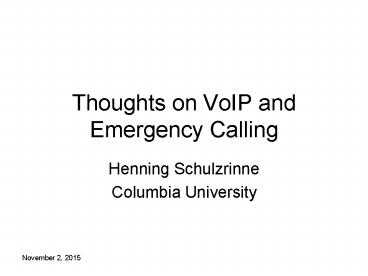Thoughts on VoIP and Emergency Calling PowerPoint PPT Presentation
Title: Thoughts on VoIP and Emergency Calling
1
Thoughts on VoIP and Emergency Calling
- Henning Schulzrinne
- Columbia University
2
VoIP emergency communications
emergency call
dispatch
emergency alert (inverse 911)
civic coordination
3
Reliability issues
- Selective routers can only route to alternate
(fixed) trunks - Typically, two
- No MSAG or ALI information for out-of-area
numbers - Numbers may not be unique (if 8 digit numbers)
- No GIS information for out-of-area numbers
4
Goals
- Any PSAP should be able to back up any other PSAP
almost instantaneously - Preferably without prior arrangement
- It should be possible to create a new PSAP in
short order - E.g., a university computer lab or a (commercial)
call center - Ingredients needed
- Internet bandwidth
- PCs with audio capability
- Call taker staff
5
How to achieve these goals?
- Allow every SR and VoIP phone to reach every PSAP
- E.g., via gateway into IP (Internet, ESN)
- Provide mapping independent
6
The core problem
Voice Service Provider (VSP) sees emergency
call but does not know caller location
ISP/IAP knows user location but does not handle
call
7
New model
- Clear separation of ISP and VSP roles
- ISP provides location, VSP provides call routing
- IP addresses are not sufficient to locate end
systems - Probable regulatory requirement ISPs must
provide (civic/geo) location information to their
subscribers even if they do not offer VoIP
services - E.g., via DHCP or other standards-based mechanism
8
UA recognition proxy resolution
mapping
9-1-1
provider.com
INVITE urnservicesos To urnservicesos ltlocat
iongt
INVITE sippsap_at_leonianj.gov To
urnservicesos ltlocationgt
9
UA recognition proxy resolution(proxy location
determination)
mapping
9-1-1
provider.com
INVITE urnservicesos To urnservicesos
INVITE sippsap_at_leonianj.gov To
urnservicesos Location ltlocationgt
PowerShow.com is a leading presentation sharing website. It has millions of presentations already uploaded and available with 1,000s more being uploaded by its users every day. Whatever your area of interest, here you’ll be able to find and view presentations you’ll love and possibly download. And, best of all, it is completely free and easy to use.
You might even have a presentation you’d like to share with others. If so, just upload it to PowerShow.com. We’ll convert it to an HTML5 slideshow that includes all the media types you’ve already added: audio, video, music, pictures, animations and transition effects. Then you can share it with your target audience as well as PowerShow.com’s millions of monthly visitors. And, again, it’s all free.
About the Developers
PowerShow.com is brought to you by CrystalGraphics, the award-winning developer and market-leading publisher of rich-media enhancement products for presentations. Our product offerings include millions of PowerPoint templates, diagrams, animated 3D characters and more.

